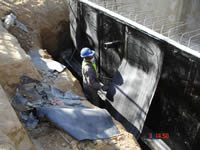How to keep residential below-grade spaces dry
Building a home requires some very careful considerations. One very important consideration involves waterproofing your foundation. Other than burning down, probably the worst thing that can happen to a residential structure is a foundation problem. The foundation is literally what the house is built on, what keeps the building where it was built, transferring the dead loads and the live loads into the ground.
The source of the vast majority of foundation problems is water. Wet soil beneath a foundation can swell or lose strength.
And that’s only the first reason to keep the foundation dry. Then there’s the little problem of wet damp basements and crawl spaces that can breed mold and make below-ground interior spaces generally unpleasant. The problem is that typical concrete is not waterproof. Although uncracked (and what concrete is uncracked?) it will typically keep out liquid water, water vapor can still penetrate quite easily. Keeping water drained away from concrete foundations and preventing it from moving through the concrete are essential to a successful structure.
Waterproofing is sprayed onto the foundation wall prior to backfilling.
Accomplishing our goal, then, of draining any water away and ensuring a dry interior space below grade can be relatively simple or fairly involved depending on geographic location, climate, topography, soil/water table conditions, and depth of the foundation. There are three components of any system designed to keep water out. These are, from the bottom up:
• Drains to move water away from the bottom of the foundation
• Wall treatment to prevent moisture from moving through the wall and to route water down to the drains
• Ground surface treatment adjacent to the building to direct surface water away
And remember that since this will mostly be underground when the building is complete, doing it right the first time is critical, because coming back to fix it is an expensive undertaking. Use the links above to learn how to accomplish these three important tasks.
Many homeowners are under the assumption that their foundation has indeed been waterproofed when in fact it has only been damproofed. There is a big difference between these two techniques. Damproofing may prevent a certain amount of water vapor from transferring into your basement, but in order to effectively protect your basement from water infiltration it must be properly waterproofed.
In the past, builders paid little attention to waterproofing foundations. Years ago builders did not even bother to apply a tar coating and they also did not have access to large sheets of plastic to retard the transfer of water vapor. This is why the basement of older homes typically has a dank moldy smell to it. Mold grows happily in environments fueled by the constant stream of moisture. In a basement, the moisture comes in through the water being carried in the soil surrounding the foundation. It enters the house through both the unprotected walls and through the concrete slab you walk across.
Waterproofing is the only way to permanently stop water and water vapor from entering your foundations walls. There are several different techniques used to accomplish this. Spray-on systems seem to work well when it comes to sealing off the pores of your concrete walls. Whatever you do, make sure you are waterproofing your foundations and not damproofing it. Damproofing is the cheap way out. It is cheap because it cost less and it is cheap because it fails to waterproof effectively. Damproofing typically consists of hot liquid asphalt sprayed on the concrete.
Damproofing
Many local building codes state that unfinished basements must be at least damproofed. The problem with spraying hot liquid asphalt on your concrete is that it will not ensure that your basement will remain dry. If the concrete cracks, which is often does as your foundation settles, water will once again be able to enter into your home because the hot asphalt will no longer be sealing the gap. Waterproofing may be a little more expensive, but it will keep these gaps sealed and keep your basement as dry as possible. This is very important, especially if you are planning to finish your basement in the near future.
As I mentioned earlier, there are several ways to waterproof your foundation. One way that is commonly used by homeowners involves applying a mixture of hot asphalt and rubber. A coating of one eighth of an inch is applied to the foundation and then an insulation panel is placed over the coating. The insulating panel serves as protection to the coating, as well as an insulator. Furthermore, the rubber in the mixture gives it a unique elastic quality that helps it fill cracks in the concrete, should they develop over time. Keep in mind, as mentioned earlier, damproofing compounds can’t do this.
Jim Spiegel
SealBoss ® Concrete Solutions
USBW
Ryan Koschuck
Dryshield
Waterproofing Association Gauteng
Paul Koning
Scott Nordhoff
Nordhoff Basement Waterproofing
[email protected]“>[email protected]
www.DryUsUp.com
Phil Llewellyn
Safeguard Chemicals SA CC


Valuable information,Thanks alot for sharing them with us.